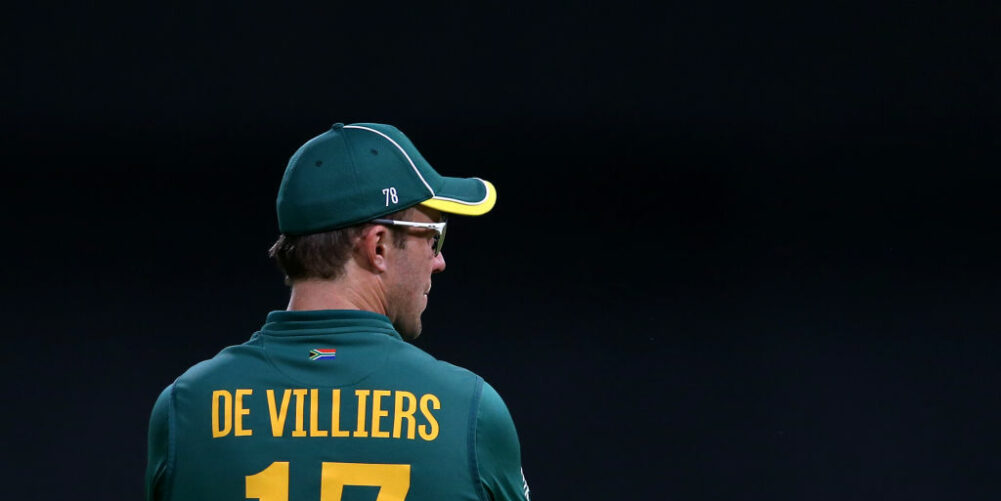(Photo: Getty Images)
By Tim Wigmore
AB de Villiers was like an explorer investigating the outer possibilities of batting. There has never been a more complete batsman. No one has so mastered the contrasting demands of the three formats, whose skills are diverging so rapidly that players talk of limited-overs and Test cricket as being completely different sports.
None of this mattered to de Villiers. Where there was a cricket ball to hit, he was uniquely adroit at doing so – a man capable of hitting the same ball for six all over the ground. The nickname – Mr 360 – was trite, but nestled within it was the acknowledgement of de Villiers’ wondrous gifts.
He is a very nice man, remarkably lacking in self-importance for a sportsman of such standing. Yet, with the bat, de Villiers is capable of great cruelty. Against the West Indies in January 2015, de Villiers hit the fastest ODI century of all time, not finishing until he had made 149 off 44 balls. A month later, in the World Cup, de Villiers made 162 not out in 66 balls: a fusion of beauty and brilliance of the ilk that no one else could match.
So imperious has de Villiers’ limited overs batting been that, for some, it has almost come to define him; a truth, in itself, that highlights the growing ascent of the shorter formats.
But, even forgetting the other forms, de Villiers was an utterly remarkable Test match player, capable of moulding matches to his will. In just a week in Australia at the end of 2012, de Villiers showcased the whole spectrum of what was possible in Test match batting. He toiled 220 balls over 33 runs in Adelaide, ‘Mr 360’ rendered strokeless by the needs of the situation. Then, in Perth, he pummelled 169, at nearly a run a ball, to set up South Africa’s victory.
Through it all, de Villiers was selfless in doing what was best for the team: a testament not only to his remarkable adaptability, but also his own commitment to team over self. In Test cricket, he batted everywhere from one to eight.
And he did so while uncomplainingly taking on the gloves whenever South Africa’s team balance required. De Villiers kept in 24 Tests; his astounding fitness was such that he made seven centuries in these games, and averaged even more than his career figure of 50.66.
But numbers were never the meaning of de Villiers. Instead, it was to stand as a symbol of what batsmanship could achieve. And at a time of such uncertainty over the future direction of the sport, de Villiers also stood out as a unifier. Test cricket lovers would gravitate towards T20s to see him bat; those reared on T20 would seek out de Villiers in Tests, to watch him play unencumbered by the limits of time.

For to see de Villiers was to see a fusion of the best of both classical batting and modern T20 hitting. His technique was so pure that few have ever off driven with more panache.
But his skills were so bountiful that he could also shuffle across to outside off-stump, go down on one knee and scoop Dale Steyn, his international team-mate and the greatest quick of the last decade, for six.
When he returned to South African Test duty over the winter, against India and Australia, de Villiers stood out over everyone else, just as he always did. And he professed to be enjoying playing as much as ever, too – part of which makes his international retirement so premature. For while he has played 13 years of international cricket, de Villiers has only just turned 34. There has been no indication that ageing has diluted his quality.
That de Villiers declared himself “tired” and “out of gas” was no slight on him; but it felt like an indictment of the incessant schedule that such a cricketer should make the decision a year out from the World Cup.
Ed Smith, now the England chief selector, once said that de Villiers was the Roger Federer of cricket. Yet in one unmistakable way the two diverge. Federer has won 20 Grand Slam singles titles. De Villiers has played 23 editions of the IPL, Cricket World Cup, Champions Trophy and WT20 and not won a single one, only reaching two finals. His distress at the chastening defeat to New Zealand in the 2015 World Cup – when he had repeatedly insisted that South Africa were the best team in the tournament – was palpable.
Most had assumed that this pain would be channelled into one final tilt at international glory in the 2019 World Cup. Instead, de Villiers’ retirement a year out of the event feels like a huge blow to the primacy of international cricket.
His form in this year’s IPL was as astounding as ever; now, seeing de Villiers in T20 leagues will be the only way of watching him at all.















